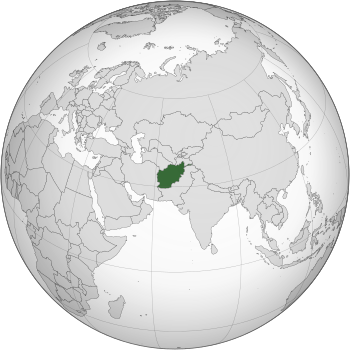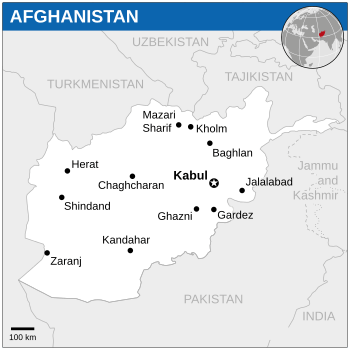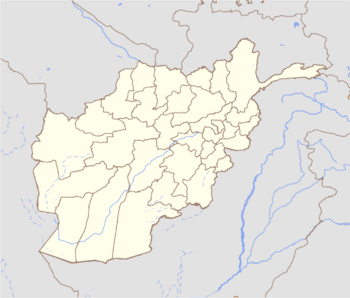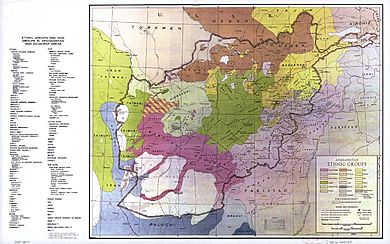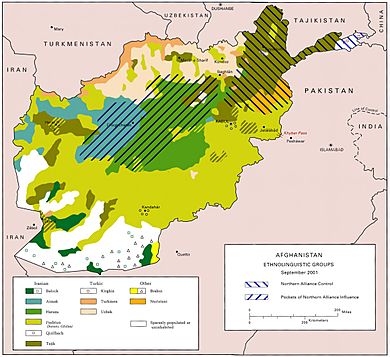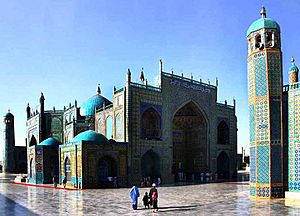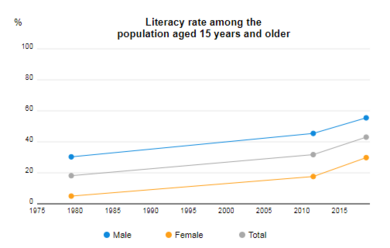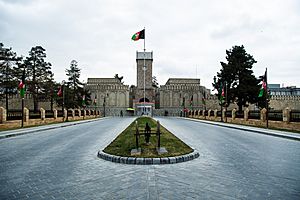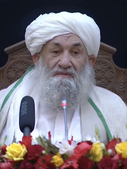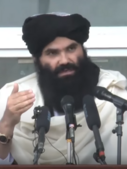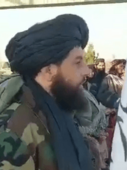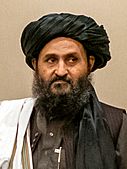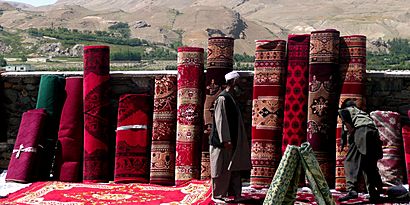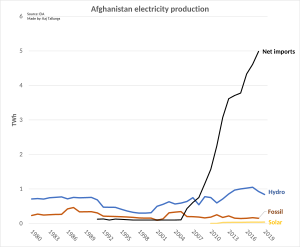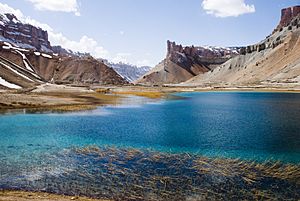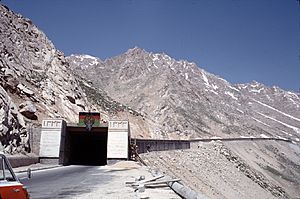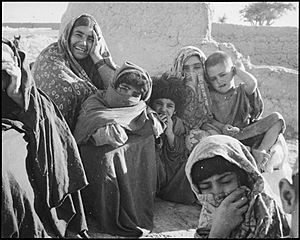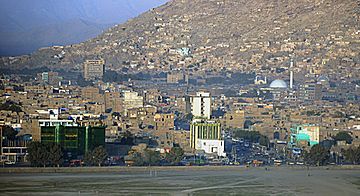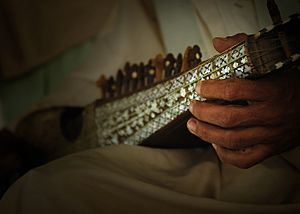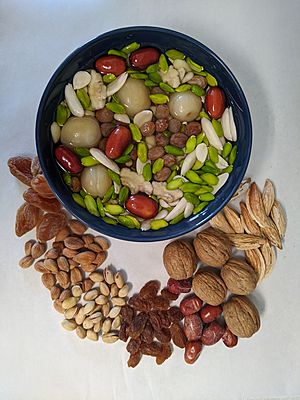Afghanistan facts for kids
Quick facts for kids
Islamic Emirate of Afghanistan
|
|
|---|---|
|
Anthem: دا د باتورانو کور
Dā Də Bātorāno Kor "This Is the Home of the Brave" |
|
| Status | UN member state under an unrecognized government |
| Capital and largest city
|
Kabul 34°31′N 69°11′E / 34.517°N 69.183°E |
| Official languages | |
| Ethnic groups
(2019 unofficial estimates)
|
|
| Religion
(2009)
|
|
| Demonym(s) | Afghan |
| Government | Unitary totalitarian provisional theocratic Islamic emirate |
|
• Supreme Leader
|
Hibatullah Akhundzada |
|
• Prime Minister
|
Abdul Kabir (acting) |
| Abdul Hakim Haqqani | |
| Legislature | none |
| Formation | |
| 1709–1738 | |
| 1747–1823 | |
|
• Emirate
|
1823–1839 |
| 1839–1842 | |
|
• Restoration of the Emirate
|
1842–1926 |
| 27 May 1863 | |
| 26 May 1879 | |
| 19 August 1919 | |
|
• Kingdom
|
9 June 1926 |
|
• Republic
|
17 July 1973 |
|
• Democratic Republic
|
27–28 April 1978 |
| 28 April 1992 | |
|
• Islamic Emirate
|
27 September 1996 |
| 26 January 2004 | |
|
• Restoration of Islamic Emirate
|
15 August 2021 |
| Area | |
|
• Total
|
652,867 km2 (252,073 sq mi) (40th) |
|
• Water (%)
|
negligible |
| Population | |
|
• 2022 estimate
|
38,346,720 (37th) |
|
• Density
|
48.08/km2 (124.5/sq mi) |
| GDP (PPP) | 2020 estimate |
|
• Total
|
$81.007 billion |
|
• Per capita
|
$2,459 |
| GDP (nominal) | 2020 estimate |
|
• Total
|
$20.136 billion |
|
• Per capita
|
$611 |
| HDI (2021) | low · 180th |
| Currency | Afghani (افغانی) (AFN) |
| Time zone | UTC+4:30 Lunar Calendar (Afghanistan Time) |
| DST is not observed | |
| Driving side | right |
| Calling code | +93 |
| ISO 3166 code | AF |
| Internet TLD | .af |
Afghanistan, officially the Islamic Emirate of Afghanistan, is a landlocked country located at the crossroads of Central Asia and South Asia. Referred to as the Heart of Asia, it is bordered by Pakistan to the east and south, Iran to the west, Turkmenistan to the northwest, Uzbekistan to the north, Tajikistan to the northeast, and China to the northeast and east. Occupying 652,864 square kilometres (252,072 sq mi) of land, the country is predominantly mountainous with plains in the north and the southwest, which are separated by the Hindu Kush mountain range. Kabul is the country's largest city and serves as its capital. As of 2021[update], Afghanistan's population is 40.2 million (officially estimated to be 32.9 million), composed of ethnic Pashtuns, Tajiks, Hazaras, Uzbeks, Turkmens, Qizilbash, Aimak, Pashayi, Baloch, Pamiris, Nuristanis, and others.
Human habitation in Afghanistan dates back to the Middle Paleolithic era, and the country's strategic location along the historic Silk Road has led it to being described, picturesquely, as the 'roundabout of the ancient world'. Popularly referred to as the graveyard of empires, the land has historically been home to various peoples and has witnessed numerous military campaigns, including those by the Persians, Alexander the Great, the Maurya Empire, Arab Muslims, the Mongols, the British, the Soviet Union, and most recently by a US-led coalition. Afghanistan also served as the source from which the Greco-Bactrians and the Mughals, amongst others, rose to form major empires. The various conquests and periods in both the Iranian and Indian cultural spheres made the area a center for Zoroastrianism, Buddhism, Hinduism, and later Islam throughout history.
The modern state of Afghanistan began with the Durrani dynasty in the 18th century, with the Durrani Afghan Empire being formed by Ahmad Shah Durrani. The Durrani Empire led conquests in which, at its peak, encompassed land that spanned from eastern Iran to northern India. However, Dost Mohammad Khan is sometimes considered to be the founder of the first modern Afghan state. Following the Durrani Empire's decline and the death of Ahmad Shah Durrani and Timur Shah, a succession crisis occured between Zaman Shah Durrani, Mahmud Shah Durrani, and Shah Shuja Durrani. Under the rule of Mahmud Shah, the execution of Fateh Khan Barakzai led to the overthrow of the Durrani dynasty, leading it to be divided into multiple smaller independent kingdoms, including but not limited to Herat, Kandahar, and Kabul. Afghanistan would be reunited in the 19th century after seven decades of civil war from 1793 to 1863, with wars of unification led by Dost Mohammad Khan from 1823 to 1863, where he conquered the independent principalities of Afghanistan under the Emirate of Kabul. Dost Mohammad died in 1863, days after his last campaign to unite Afghanistan, and Afghanistan was consequently thrown back into civil war with fighting amongst his successors. During this time, Afghanistan became a buffer state in the Great Game between the British Empire (in British-ruled India) and the Russian Empire. From India, the British attempted to subjugate Afghanistan but were repelled in the First Anglo-Afghan War. However, the Second Anglo-Afghan War saw a British victory and the successful establishment of British political influence over Afghanistan. Following the Third Anglo-Afghan War in 1919, Afghanistan became free of foreign political hegemony, and emerged as the independent Kingdom of Afghanistan in June 1926 under Amanullah Khan. This monarchy lasted almost half a century, until Zahir Shah was overthrown in 1973, following which the Republic of Afghanistan was established.
Since the late 1970s, Afghanistan's history has been dominated by extensive warfare, including coups, invasions, insurgencies, and civil wars. The conflict began in 1978 when a communist revolution established a socialist state, and subsequent infighting prompted the Soviet Union to invade Afghanistan in 1979. Mujahideen fought against the Soviets in the Soviet–Afghan War and continued fighting amongst themselves following the Soviets' withdrawal in 1989. The Islamic fundamentalist Taliban controlled most of the country by 1996, but their Islamic Emirate of Afghanistan received little international recognition before its overthrow in the 2001 US invasion of Afghanistan. The Taliban returned to power in 2021 after capturing Kabul and overthrowing the government of the Islamic Republic of Afghanistan, thus bringing an end to the 2001–2021 war. Although initially claiming it would form an inclusive government for the country, in September 2021 the Taliban re-established the Islamic Emirate of Afghanistan with an interim government made up entirely of Taliban members. The Taliban government remains internationally unrecognized.
Afghanistan is rich in natural resources, including lithium, iron, zinc, and copper. It is also the world's third largest producer of both saffron and cashmere. The country is a member of the South Asian Association for Regional Cooperation and a founding member of the Organization of Islamic Cooperation. Due to the effects of war in recent decades, the country has dealt with high levels of terrorism, poverty, and child malnutrition. Afghanistan remains among the world's least developed countries, ranking 180th in the Human development Index. Afghanistan's gross domestic product (GDP) is $81 billion by purchasing power parity and $20.1 billion by nominal values. Per capita, its GDP is amongst the lowest of any country as of 2020[update].
Contents
Etymology
Some scholars suggest that the root name Afghān is derived from the Sanskrit word Aśvakan, which was the name used for ancient inhabitants of the Hindu Kush. Aśvakan literally means "horsemen", "horse breeders", or "cavalrymen" (from aśva, the Sanskrit and Avestan words for "horse"). However, others such as Ibrahim Khan have contended that the word Afghan comes from Bactrian.
Historically, the ethnonym Afghān was used to refer to ethnic Pashtuns. The Arabic and Persian form of the name, Afġān, was first attested in the 10th-century geography book Hudud al-'Alam. The last part of the name, "-stan", is a Persian suffix meaning "place of". Therefore, "Afghanistan" translates to "land of the Afghans", or "land of the Pashtuns" in a historical sense. According to the third edition of the Encyclopedia of Islam:
The name Afghanistan (Afghānistān, land of the Afghans / Pashtuns, afāghina, sing. afghān) can be traced to the early eighth/fourteenth century, when it designated the easternmost part of the Kartid realm. This name was later used for certain regions in the Ṣafavid and Mughal empires that were inhabited by Afghans. While based on a state-supporting elite of Abdālī / Durrānī Afghans, the Sadūzāʾī Durrānī polity that came into being in 1160 / 1747 was not called Afghanistan in its own day. The name became a state designation only during the colonial intervention of the nineteenth century.
The term "Afghanistan" was officially used in 1855, when the British recognized Dost Mohammad Khan as king of Afghanistan.
Geography
Afghanistan is located in Southern-Central Asia. The region centered at Afghanistan is considered the "crossroads of Asia", and the country has had the nickname Heart of Asia. The renowned Urdu poet Allama Iqbal once wrote about the country:
Asia is a body of water and earth, of which the Afghan nation is the heart. From its discord, the discord of Asia; and from its accord, the accord of Asia.
At over 652,864 km2 (252,072 sq mi), Afghanistan is the world's 41st largest country, slightly bigger than France and smaller than Myanmar, and about the size of Texas in the United States. There is no coastline, as Afghanistan is landlocked. Afghanistan shares its longest land border (the Durand Line) with Pakistan to the east and south, followed by borders with Tajikistan to the northeast, Iran to the west, Turkmenistan to the north-west, Uzbekistan to the north and China to the far northeast; India recognizes a border with Afghanistan through Pakistani-administered Kashmir. Clockwise from south-west, Afghanistan shares borders with the Sistan and Baluchestan Province, South Khorasan Province and Razavi Khorasan Province of Iran; Ahal Region, Mary Region and Lebap Region of Turkmenistan; Surxondaryo Region of Uzbekistan; Khatlon Region and Gorno-Badakhshan Autonomous Region of Tajikistan; Xinjiang Uyghur Autonomous Region of China; and the Gilgit-Baltistan territory, Khyber Pakhtunkhwa province and Balochistan province of Pakistan.
The geography in Afghanistan is varied, but is mostly mountainous and rugged, with some unusual mountain ridges accompanied by plateaus and river basins. It is dominated by the Hindu Kush range, the western extension of the Himalayas that stretches to eastern Tibet via the Pamir Mountains and Karakoram Mountains in Afghanistan's far north-east. Most of the highest points are in the east consisting of fertile mountain valleys, often considered part of the "Roof of the World". The Hindu Kush ends at the west-central highlands, creating plains in the north and southwest, namely the Turkestan Plains and the Sistan Basin; these two regions consist of rolling grasslands and semi-deserts, and hot windy deserts, respectively. Forests exist in the corridor between Nuristan and Paktika provinces (see East Afghan montane conifer forests), and tundra in the northeast. The country's highest point is Noshaq, at 7,492 m (24,580 ft) above sea level. The lowest point lies in Jowzjan Province along the Amu River bank, at 258 m (846 ft) above sea level.
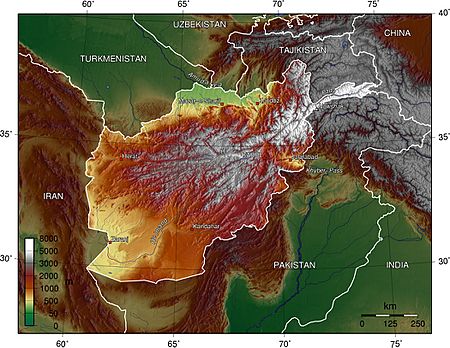
Despite having numerous rivers and reservoirs, large parts of the country are dry. The endorheic Sistan Basin is one of the driest regions in the world. The Amu Darya rises at the north of the Hindu Kush, while the nearby Hari Rud flows west towards Herat, and the Arghandab River from the central region southwards. To the south and west of the Hindu Kush flow a number of streams that are tributaries of the Indus River, such as the Helmand River. One exception is the Kabul River which flows in an easterly direction to the Indus ending at the Indian Ocean. Afghanistan receives heavy snow during the winter in the Hindu Kush and Pamir Mountains, and the melting snow in the spring season enters the rivers, lakes, and streams. However, two-thirds of the country's water flows into the neighboring countries of Iran, Pakistan, and Turkmenistan. As reported in 2010, the state needs more than US$2 billion to rehabilitate its irrigation systems so that the water is properly managed.
The northeastern Hindu Kush mountain range, in and around the Badakhshan Province of Afghanistan, is in a geologically active area where earthquakes may occur almost every year. They can be deadly and destructive, causing landslides in some parts or avalanches during the winter. The last strong earthquakes were in 1998, which killed about 6,000 people in Badakhshan near Tajikistan. This was followed by the 2002 Hindu Kush earthquakes in which over 150 people were killed and over 1,000 injured. A 2010 earthquake left 11 Afghans dead, over 70 injured, and more than 2,000 houses destroyed. In June 2022, a destructive 5.9 earthquake struck near the border with Pakistan, killing at least 1,150 people and sparking fears of a major humanitarian crisis.
Climate
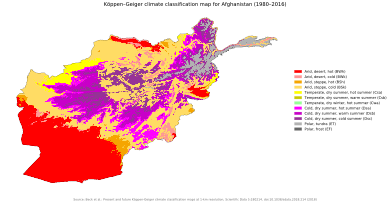
Afghanistan has a continental climate with harsh winters in the central highlands, the glaciated northeast (around Nuristan), and the Wakhan Corridor, where the average temperature in January is below −15 °C (5 °F) and can reach −26 °C (−15 °F), and hot summers in the low-lying areas of the Sistan Basin of the southwest, the Jalalabad basin in the east, and the Turkestan plains along the Amu River in the north, where temperatures average over 35 °C (95 °F) in July and can go over 43 °C (109 °F). The country is generally arid in the summers, with most rainfall falling between December and April. The lower areas of northern and western Afghanistan are the driest, with precipitation more common in the east. Although proximate to India, Afghanistan is mostly outside the monsoon zone, except the Nuristan Province which occasionally receives summer monsoon rain.
Biodiversity
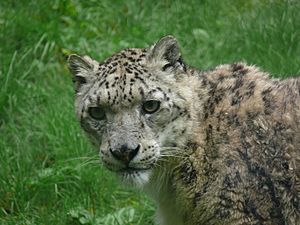
Several types of mammals exist throughout Afghanistan. Snow leopards, Siberian tigers and brown bears live in the high elevation alpine tundra regions. The Marco Polo sheep exclusively live in the Wakhan Corridor region of north-east Afghanistan. Foxes, wolves, otters, deer, wild sheep, lynx and other big cats populate the mountain forest region of the east. In the semi-desert northern plains, wildlife include a variety of birds, hedgehogs, gophers, and large carnivores such as jackals and hyenas.
Gazelles, wild pigs and jackals populate the steppe plains of the south and west, while mongoose and cheetahs exist in the semi-desert south. Marmots and ibex also live in the high mountains of Afghanistan, and pheasants exist in some parts of the country. The Afghan hound is a native breed of dog known for its fast speed and its long hair; it is relatively known in the west.
Endemic fauna of Afghanistan includes the Afghan flying squirrel, Afghan snowfinch, Paradactylodon (or the "Paghman mountain salamander"), Stigmella kasyi, Vulcaniella kabulensis, Afghan leopard gecko, Wheeleria parviflorellus, amongst others. Endemic flora include Iris afghanica. Afghanistan has a wide variety of birds despite its relatively arid climate – an estimated 460 species of which 235 breed within.
The forest region of Afghanistan has vegetation such as pine trees, spruce trees, fir trees and larches, whereas the steppe grassland regions consist of broadleaf trees, short grass, perennial plants and shrublands. The colder high elevation regions are composed of hardy grasses and small flowering plants. Several regions are designated protected areas; there are three national parks: Band-e Amir, Wakhan and Nuristan. Afghanistan had a 2018 Forest Landscape Integrity Index mean score of 8.85/10, ranking it 15th globally out of 172 countries.
Demographics
The population of Afghanistan was estimated at 32.9 million as of 2019 by the Afghanistan Statistics and Information Authority, whereas the UN estimates over 38.0 million. In 1979 the total population was reported to be about 15.5 million. About 23.9% of them are urbanite, 71.4% live in rural areas, and the remaining 4.7% are nomadic. An additional 3 million or so Afghans are temporarily housed in neighboring Pakistan and Iran, most of whom were born and raised in those two countries. As of 2013, Afghanistan was the largest refugee-producing country in the world, a title held for 32 years.
The current population growth rate is 2.37%, one of the highest in the world outside of Africa. This population is expected to reach 82 million by 2050 if current population trends continue. The population of Afghanistan increased steadily until the 1980s, when civil war caused millions to flee to other countries such as Pakistan. Millions have since returned and the war conditions contribute to the country having the highest fertility rate outside Africa. Afghanistan's healthcare has recovered since the turn of the century, causing falls in infant mortality and increases in life expectancy, although it has the lowest life expectance of any country outside Africa. This (along with other factors such as returning refugees) caused rapid population growth in the 2000s that has only recently started to slow down. The Gini coefficient in 2008 was 27.8.
Ethnicity and languages
Afghans are divided into several ethnolinguistic groups. According to research data by several institutions in 2019, the Pashtuns are the largest ethnic group, comprising 42%, followed by Tajiks, comprising 27% of the country's population. The other two major ethnic groups are the Hazaras and Uzbeks, each at 9%. A further 10 other ethnic groups are recognized and each are represented in the Afghan National Anthem.
Dari and Pashto are the official languages of Afghanistan; bilingualism is very common. Dari, which is also referred to as Eastern Persian as it is a variety of and mutually intelligible with Persian (and very often called 'Farsi' by some Afghans like in Iran) functions as the lingua franca in Kabul as well as in much of the northern and northwestern parts of the country. Native speakers of Dari, of any ethnicity, are sometimes called Farsiwans. Pashto is the native tongue of the Pashtuns, although many of them are also fluent in Dari while some non-Pashtuns are fluent in Pashto. Despite the Pashtuns having been dominant in Afghan politics for centuries, Dari remained the preferred language for government and bureaucracy. According to CIA World Factbook, Dari Persian is spoken by 78% (L1 + L2) and functions as the lingua franca, while Pashto is spoken by 50%, Uzbek 10%, English 5%, Turkmen 2%, Urdu 2%, Pashayi 1%, Nuristani 1%, Arabic 1%, and Balochi 1% (2021 est). Data represent the most widely spoken languages; shares sum to more than 100% because there is much bilingualism in the country and because respondents were allowed to select more than one language. There are a number of smaller regional languages, including Uzbek, Turkmen, Balochi, Pashayi, and Nuristani.
When it comes to foreign languages among the populace, many are able to speak or understand Hindustani (Urdu-Hindi), partly due to returning Afghan refugees from Pakistan and the popularity of Bollywood films respectively. English is also understood by some of the population, and has been gaining popularity as of the 2000s. Some Afghans retain some ability in Russian, which was taught in public schools during the 1980s.
Religion
The CIA estimated in 2009 that 99.7% of the Afghan population was Muslim and most are thought to adhere to the Sunni Hanafi school. According to Pew Research Center, as much as 90% are of the Sunni denomination, 7% Shia and 3% non-denominational. The CIA Factbook variously estimates up to 89.7% Sunni or up to 15% Shia.
Afghan Sikhs and Hindus are also found in certain major cities (namely Kabul, Jalalabad, Ghazni, Kandahar) accompanied by gurdwaras and mandirs. According to Deutsche Welle in September 2021, 250 remain in the country after 67 were evacuated to India.
There was a small Jewish community in Afghanistan, living mainly in Herat and Kabul. Over the years, this small community was forced leave due to decades of warfare and religious persecution. By the end of the twentieth century, nearly the entire community had emigrated to Israel and the United States, with one known exception, Herat-born Zablon Simintov. He remained for years, being the caretaker of the only remaining Afghan synagogue. He left the country for the US after the second Taliban takeover. A woman who left shortly after him has since been identified as the likely last Jew in Afghanistan.
Afghan Christians, who number 500–8,000, practice their faith secretly due to intense societal opposition, and there are no public churches.
Urbanization
As estimated by the CIA World Factbook, 26% of the population was urbanized as of 2020. This is one of the lowest figures in the world; in Asia it is only higher than Cambodia, Nepal and Sri Lanka. Urbanization has increased rapidly, particularly in the capital Kabul, due to returning refugees from Pakistan and Iran after 2001, internally displaced people, and rural migrants. Urbanization in Afghanistan is different from typical urbanization in that it is centered on just a few cities.
The only city with over a million residents is its capital, Kabul, located in the east of the country. The other large cities are located generally in the "ring" around the Central Highlands, namely Kandahar in the south, Herat in the west, Mazar-i-Sharif, Kunduz in the north, and Jalalabad in the east.
Template:Largest cities of Afghanistan
Education
Education in Afghanistan is overseen by the Ministry of Education and the Ministry of Higher Education. There are over 16,000 schools in the country and roughly 9 million students. Of this, about 60% are males and 40% females. However, the new regime has thus far forbidden female teachers and female students from returning to secondary schools. Over 174,000 students are enrolled in different universities around the country. About 21% of these are females. Former Education Minister Ghulam Farooq Wardak had stated that construction of 8,000 schools is required for the remaining children who are deprived of formal learning. As of 2018 the literacy rate of the population age 15 and older is 43.02% (males 55.48% and females 29.81%).
The top universities in Afghanistan are the American University of Afghanistan (AUAF) followed by Kabul University (KU), both of which are located in Kabul. The National Military Academy of Afghanistan, modeled after the United States Military Academy at West Point, was a four-year military development institution dedicated to graduating officers for the Afghan Armed Forces. The Afghan Defense University was constructed near Qargha in Kabul. Major universities outside of Kabul include Kandahar University in the south, Herat University in the northwest, Balkh University and Kunduz University in the north, Nangarhar University and Khost University in the east. Kabul University was founded in 1932 and is a respected institute that played a significant part in the country's education; from the 1960s the Kabul University was also a hotbed of radical political ideologies such as Marxism and Islamism, which played major parts in society, politics and the war that began in 1978.
After the Taliban regained power in 2021, it became unclear to what extent female education would continue in the country. In March 2022, after they had been closed for some time, it was announced that secondary education would be reopened shortly. However, shortly before reopening, the order was rescinded and schools for older girls remained closed.
Despite the ban, six provinces, Balkh, Kunduz, Jowzjan, Sar-I-Pul, Faryab, and the Day Kundi provinces still allow girl's schools from grade 6 and up.
Health
According to the Human Development Index, Afghanistan is the 15th least developed country in the world. The average life expectancy is estimated to be around 60 years. The country's maternal mortality rate is 396 deaths/100,000 live births and its infant mortality rate is 66 to 112.8 deaths in every 1,000 live births. The Ministry of Public Health plans to cut the infant mortality rate to 400 for every 100,000 live births before 2020. The country has more than 3,000 midwives, with an additional 300 to 400 being trained each year.
There are over 100 hospitals in Afghanistan, with the most advanced treatments being available in Kabul. The French Medical Institute for Children and Indira Gandhi Children's Hospital in Kabul are the leading children's hospitals in the country. Some of the other leading hospitals in Kabul include the Jamhuriat Hospital and Jinnah Hospital. In spite of all this, many Afghans travel to Pakistan and India for advanced treatment.
It was reported in 2006 that nearly 60% of the Afghan population lives within a two-hour walk of the nearest health facility. Disability rate is also high in Afghanistan due to the decades of war. It was reported recently that about 80,000 people are missing limbs. Non-governmental charities such as Save the Children and Mahboba's Promise assist orphans in association with governmental structures. Demographic and Health Surveys is working with the Indian Institute of Health Management Research and others to conduct a survey in Afghanistan focusing on maternal death, among other things.
Governance
Following the effective collapse of the Islamic Republic of Afghanistan during the 2021 Taliban offensive, the Taliban declared the country an Islamic Emirate. A new caretaker government was announced on 7 September. As of 8 September 2021[update], no other country had formally recognized the Islamic Emirate of Afghanistan as the de jure government of Afghanistan.
A traditional instrument of governance in Afghanistan is the loya jirga (grand assembly), a Pashtun consultative meeting that was mainly organized for choosing a new head of state, adopting a new constitution, or to settle national or regional issue such as war. Loya jirgas have been held since at least 1747, with the most recent one occurring in August 2020.
Development of Taliban government
Acting Prime Minister
(2021–2023)
First Deputy Leader and Acting Interior Minister
Second Deputy Leader and Acting Defense Minister
Third Deputy Leader and Acting First Deputy Prime Minister
On 17 August 2021, the leader of the Taliban-affiliated Hezb-e-Islami Gulbuddin party, Gulbuddin Hekmatyar, met with both Hamid Karzai, the former President of Afghanistan, and Abdullah Abdullah, the former chairman of the High Council for National Reconciliation and former Chief Executive, in Doha, Qatar, with the aim of forming a national unity government. President Ashraf Ghani, having fled the country during the Taliban advance to either Tajikistan or Uzbekistan, emerged in the United Arab Emirates and said that he supported such negotiations and was in talks to return to Afghanistan. Many figures within the Taliban generally agreed that continuation of the 2004 Constitution of Afghanistan may, if correctly applied, be workable as the basis for the new religious state as their objections to the former government were political, and not religious.
Hours after the final flight of American troops left Kabul on 30 August, a Taliban official interviewed said that a new government would likely be announced as early as Friday 3 September after Jumu'ah. It was added that Hibatullah Akhundzada would be officially named Emir, with cabinet ministers being revealed at the Arg in an official ceremony. Abdul Ghani Baradar would be named head of government as Prime Minister, while other important positions would go to Sirajuddin Haqqani and Mullah Yaqoob. Beneath the supreme leader, day-to-day governance will be entrusted to the cabinet.
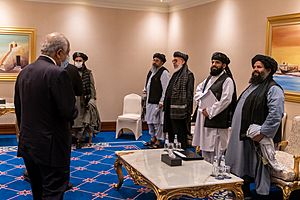
According to CNN, the new government is likely to be a unitary Deobandist Islamic republic. In a report by CNN-News18, sources said the new government was going to be governed similarly to Iran with Haibatullah Akhundzada as supreme leader similar to the role of Saayid Ali Khamenei, and would be based out of Kandahar. Baradar or Yaqoob would be head of government as Prime Minister. The government's ministries and agencies will be under a cabinet presided over by the Prime Minister. The Supreme Leader would preside over an executive body known Supreme Council with anywhere from 11 to 72 members. Abdul Hakim Haqqani is likely to be promoted to Chief Justice. According to the report, the new government will take place within the framework of an amended 1964 Constitution of Afghanistan.
However, later interviews disclosed to News18 that negotiations were not yet completed and that representatives were still in Kandahar, and that the announcement of the new government would not take place until 4 September or later. Government formation was further delayed with the announcement postponed to some time during the week of 6 September, due to concerns about forming a broad-based government acceptable to the international community. It was later added however that the Taliban's Rahbari Shura, the group's leadership council was divided between the hardline Haqqani Network and moderate Abdul Ghani Baradar over appointments needed to form an "inclusive" government. This culminated in a skirmish which led to Baradar being injured and treated in Pakistan. It was speculated that the government would be announced on 11 September 2021, the 20th anniversary of the 9/11 attacks, with invitations possibly being extended to the governments of Turkey, China, Iran, Pakistan, and Qatar.
As of early September, the Taliban were planning the Cabinet to be men-only, stating that women would not be allowed to "work in high-ranking posts" in the government and that women were "ruled out" from the Cabinet. Journalists and other human rights activists, mostly women, protested in Herat and Kabul, calling for women to be included in the Cabinet. The acting Cabinet announced on 7 September was men-only, and the Ministry of Women's Affairs appeared to have been abolished. On March 23, 2022, there were reports a cabinet shakeup was underway as another meeting of the Leadership Council was held in Kandahar for the second time since the Taliban Islamic Movement came to power as a way to get international recognition. The last meeting of the Leadership Council was held from August 28, 2021, to August 30, 2021.
Administrative divisions
Afghanistan is administratively divided into 34 provinces (wilayat). Each province has a governor and a capital. The country is further divided into nearly 400 provincial districts, each of which normally covers a city or several villages. Each district is represented by a district governor.
The provincial governors are now appointed by the Prime Minister of Afghanistan, and the district governors are selected by the provincial governors. The provincial governors are representatives of the central government in Kabul and are responsible for all administrative and formal issues within their provinces. There are also provincial councils that are elected through direct and general elections for four years. The functions of provincial councils are to take part in provincial development planning and to participate in the monitoring and appraisal of other provincial governance institutions.
According to article 140 of the constitution and the presidential decree on electoral law, mayors of cities should be elected through free and direct elections for a four-year term. In practice however, mayors are appointed by the government.
The following is a list of all the 34 provinces in alphabetical order:
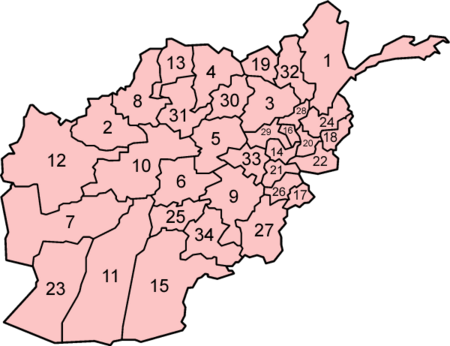
Foreign relations
Afghanistan became a member of the United Nations in 1946. Historically, Afghanistan had strong relations with Germany, one of the first countries to recognize Afghanistan's independence in 1919; the Soviet Union, which provided much aid and military training for Afghanistan's forces and includes the signing of a Treaty of Friendship in 1921 and 1978; and India, with which a friendship treaty was signed in 1950. Relations with Pakistan have often been tense for various reasons such as the Durand Line border issue and alleged Pakistani involvement in Afghan insurgent groups.
The present Islamic Emirate of Afghanistan is currently internationally unrecognized, but has had notable unofficial ties with China, Pakistan, and Qatar. Under the previous Islamic Republic of Afghanistan, it enjoyed cordial relations with a number of NATO and allied nations, particularly the United States, Canada, United Kingdom, Germany, Australia, and Turkey. In 2012, the United States and the then-republic in Afghanistan signed their Strategic Partnership Agreement in which Afghanistan became a major non-NATO ally. Such qualification was rescinded by US President Joe Biden in July 2022.
Military
The Armed Forces of the Islamic Emirate of Afghanistan captured a large amount of weapons, hardware, vehicles, aerocrafts, and equipment from the Afghan National Security Forces following the 2021 Taliban offensive and the Fall of Kabul. The total value of the captured equipment has been estimated at US$83 billion.
Human rights
Homosexuality is taboo in Afghan society; according to the Penal Code, homosexual intimacy is punished by up to a year in prison. With implementing Sharia law offenders can be punished by death. However an ancient tradition involving male homosexual acts between children and older men (typically wealthy warlords or elite people) called bacha bazi persists.
Religious minorities such as Sikhs, Hindus, and Christians have reportedly faced persecution in the country.
Since May 2022, all women in Afghanistan have been required by law to wear full-body coverings when in public (either a burqa or an abaya paired with a niqāb, which leaves only the eyes uncovered). In a May interview with Christiane Amanpour, First Deputy Leader Sirajuddin Haqqani claimed the decree is only advisory and no form of hijab is compulsory in Afghanistan, though this contradicts the reality. It has been speculated that there is a genuine internal policy division over women's rights between hardliners, including Leader Hibatullah Akhundzada, and pragmatists, though they publicly present a united front. Another decree was issued shortly after the first, requiring female TV presenters to cover their faces during broadcasts.
In May 2022, the Taliban dissolved Afghanistan's Human Rights Commission along with four other government departments, citing the country's budget deficit.
Economy
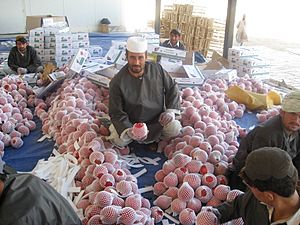
Afghanistan's nominal GDP was $20.1 billion in 2020, or $81 billion by purchasing power parity (PPP). Its GDP per capita is $2,459 (PPP) and $611 by nominal. Despite having $1 trillion or more in mineral deposits, it remains one of the world's least developed countries. Afghanistan's rough physical geography and its landlocked status has been cited as reasons why the country has always been among the least developed in the modern era – a factor where progress is also slowed by contemporary conflict and political instability. The country imports over $7 billion worth of goods but exports only $784 million, mainly fruits and nuts. It has $2.8 billion in external debt. The service sector contributed the most to the GDP (55.9%) followed by agriculture (23%) and industry (21.1%).
While the nation's current account deficit is largely financed with donor money, only a small portion is provided directly to the government budget. The rest is provided to non-budgetary expenditure and donor-designated projects through the United Nations system and non-governmental organizations.
Da Afghanistan Bank serves as the central bank of the nation and the Afghani (AFN) is the national currency, with an exchange rate of about 75 Afghanis to 1 US dollar. A number of local and foreign banks operate in the country, including the Afghanistan International Bank, New Kabul Bank, Azizi Bank, Pashtany Bank, Standard Chartered Bank, and the First Micro Finance Bank.
One of the main drivers for the current economic recovery is the return of over 5 million expatriates, who brought with them entrepreneurship and wealth-creating skills as well as much needed funds to start up businesses. Many Afghans are now involved in construction, which is one of the largest industries in the country. Some of the major national construction projects include the $35 billion New Kabul City next to the capital, the Aino Mena project in Kandahar, and the Ghazi Amanullah Khan Town near Jalalabad. Similar development projects have also begun in Herat, Mazar-e-Sharif, and other cities. An estimated 400,000 people enter the labor market each year.
Several small companies and factories began operating in different parts of the country, which not only provide revenues to the government but also create new jobs. Improvements to the business environment have resulted in more than $1.5 billion in telecom investment and created more than 100,000 jobs since 2003. Afghan rugs are becoming popular again, allowing many carpet dealers around the country to hire more workers; in 2016–17 it was the fourth most exported group of items.
Afghanistan is a member of WTO, SAARC, ECO, and OIC. It holds an observer status in SCO. In 2018, a majority of imports come from either Iran, China, Pakistan and Kazakhstan, while 84% of exports are to Pakistan and India.
Since the Taliban's takeover of the country in August 2021, the United States has frozen about $9 billion in assets belonging to the Afghan central bank, blocking the Taliban from accessing billions of dollars held in US bank accounts.
Agriculture

Agricultural production is the backbone of Afghanistan's economy and has traditionally dominated the economy, employing about 40% of the workforce as of 2018. The country is known for producing pomegranates, grapes, apricots, melons, and several other fresh and dry fruits.
Saffron, the most expensive spice, grows in Afghanistan, particularly Herat Province. In recent years, there has been an uptick in saffron production, which authorities and farmers trying to replace poppy cultivation. Between 2012 and 2019, the saffron cultivated and produced in Afghanistan was consecutively ranked the world's best by the International Taste and Quality Institute. Production hit record high in 2019 (19,469 kg of saffron), and one kilogram is sold domestically between $634 and $1147.
The availability of cheap diesel-powered water pumps imported from China and Pakistan, and in the 2010s, of cheap solar power to pump water, resulted in expansion of agriculture and population in the southwestern deserts of Afghanistan in Kandahar Province, Helmand Province and Nimruz Province in the 2010s. Wells have gradually been deepened, but water resources are limited.
Mining
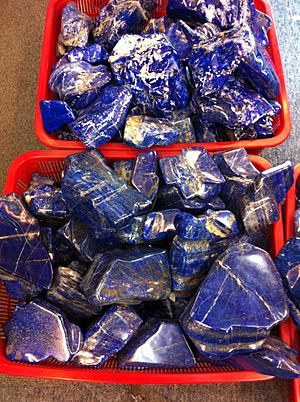
The country's natural resources include: coal, copper, iron ore, lithium, uranium, rare earth elements, chromite, gold, zinc, talc, barite, sulfur, lead, marble, precious and semi-precious stones, natural gas, and petroleum. In 2010, US and Afghan government officials estimated that untapped mineral deposits located in 2007 by the US Geological Survey are worth at least $1 trillion.
Michael E. O'Hanlon of the Brookings Institution estimated that if Afghanistan generates about $10 billion per year from its mineral deposits, its gross national product would double and provide long-term funding for Afghan security forces and other critical needs. The United States Geological Survey (USGS) estimated in 2006 that northern Afghanistan has an average 460 million m3 (2.9 billion bbl) of crude oil, 440 billion m3 (15.7 trillion cu ft) of natural gas, and 67 billion L (562 million US bbl) of natural gas liquids. In 2011, Afghanistan signed an oil exploration contract with China National Petroleum Corporation (CNPC) for the development of three oil fields along the Amu Darya river in the north.
The country has significant amounts of lithium, copper, gold, coal, iron ore, and other minerals. The Khanashin carbonatite in Helmand Province contains 1,000,000 tonnes (980,000 long tons; 1,100,000 short tons) of rare earth elements. In 2007, a 30-year lease was granted for the Aynak copper mine to the China Metallurgical Group for $3 billion, making it the biggest foreign investment and private business venture in Afghanistan's history. The state-run Steel Authority of India won the mining rights to develop the huge Hajigak iron ore deposit in central Afghanistan. Government officials estimate that 30% of the country's untapped mineral deposits are worth at least $1 trillion. One official asserted that "this will become the backbone of the Afghan economy" and a Pentagon memo stated that Afghanistan could become the "Saudi Arabia of lithium". The lithium reserves of 21 Mio. tons could amount to the ones of Bolivia, which is currently viewed as the country with the largest lithium reserves. Other larger deposits are the ones of bauxite and cobalt. In a 2011 news story, the CSM reported, "The United States and other Western nations that have borne the brunt of the cost of the Afghan war have been conspicuously absent from the bidding process on Afghanistan's mineral deposits, leaving it mostly to regional powers."
Access to biocapacity in Afghanistan is lower than world average. In 2016, Afghanistan had 0.43 global hectares of biocapacity per person within its territory, much less than the world average of 1.6 global hectares per person. In 2016 Afghanistan used 0.73 global hectares of biocapacity per person - their ecological footprint of consumption. This means they use just under double as much biocapacity as Afghanistan contains. As a result, Afghanistan is running a biocapacity deficit.
Infrastructure
Energy
According to the World Bank, 98% of the rural population have access to electricity in 2018, up from 28% in 2008. Overall the figure stands at 98.7%. As of 2016, Afghanistan produces 1,400 megawatts of power, but still imports the majority of electricity via transmission lines from Iran and the Central Asian states. The majority of electricity production is via hydropower, helped by the amount of rivers and streams that flow from the mountains. However electricity is not always reliable and blackouts happen, including in Kabul. In recent years an increasing number of solar, biomass and wind power plants have been constructed. Currently under development are the CASA-1000 project which will transmit electricity from Kyrgyzstan and Tajikistan, and the Turkmenistan-Afghanistan-Pakistan-India (TAPI) gas pipeline. Power is managed by the Da Afghanistan Breshna Sherkat (DABS, Afghanistan Electricity Company).
Important dams include the Kajaki Dam, Dahla Dam, and the Sardeh Band Dam.
Tourism
Tourism is a small industry in Afghanistan due to security issues. Nevertheless, some 20,000 foreign tourists visit the country annually as of 2016. In particular an important region for domestic and international tourism is the picturesque Bamyan Valley, which includes lakes, canyons and historical sites, helped by the fact it is in a safe area away from insurgent activity. Smaller numbers visit and trek in regions such as the Wakhan Valley, which is also one of the world's most remote communities. From the late 1960s onwards, Afghanistan was a popular stop on the famous hippie trail, attracting many Europeans and Americans. Coming from Iran, the trail traveled through various Afghan provinces and cities including Herat, Kandahar and Kabul before crossing to northern Pakistan, northern India, and Nepal. Tourism peaked in 1977, the year before the start of political instability and armed conflict.
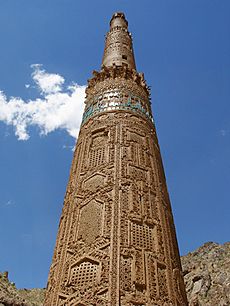
The city of Ghazni has significant history and historical sites, and together with Bamyan city have in recent years been voted Islamic Cultural Capital and South Asia Cultural Capital respectively. The cities of Herat, Kandahar, Balkh, and Zaranj are also very historic. The Minaret of Jam in the Hari River valley is a UNESCO World Heritage Site. A cloak reputedly worn by Islam's prophet Muhammad is kept inside the Shrine of the Cloak in Kandahar, a city founded by Alexander the Great and the first capital of Afghanistan. The citadel of Alexander in the western city of Herat has been renovated in recent years and is a popular attraction. In the north of the country is the Shrine of Ali, believed by many to be the location where Ali was buried. The National Museum of Afghanistan is located in Kabul and hosts a large number of Buddhist, Bactrian Greek and early Islamic antiquities; the museum suffered greatly by civil war but has been slowly restoring since the early 2000s.
Communication
Telecommunication services in Afghanistan are provided by Afghan Telecom, Afghan Wireless, Etisalat, MTN Group, and Roshan. The country uses its own space satellite called Afghansat 1, which provides services to millions of phone, internet, and television subscribers. By 2001 following years of civil war, telecommunications was virtually a non-existent sector, but by 2016 it had grown to a $2 billion industry, with 22 million mobile phone subscribers and 5 million internet users. The sector employs at least 120,000 people nationwide.
Transportation
Due to Afghanistan's geography, transport between various parts of the country has historically been difficult. The backbone of Afghanistan's road network is Highway 1, often called the "Ring Road", which extends for 2,210 kilometres (1,370 mi) and connects five major cities: Kabul, Ghazni, Kandahar, Herat and Mazar-i-Sharif, with spurs to Kunduz and Jalalabad and various border crossings, while skirting around the mountains of the Hindu Kush.
The Ring Road is crucially important for domestic and international trade and the economy. A key portion of the Ring Road is the Salang Tunnel, completed in 1964, which facilitates travel through the Hindu Kush mountain range and connects northern and southern Afghanistan. It is the only land route that connects Central Asia to the Indian subcontinent. Several mountain passes allow travel between the Hindu Kush in other areas. Serious traffic accidents are common on Afghan roads and highways, particularly on the Kabul–Kandahar and the Kabul–Jalalabad Road. Traveling by bus in Afghanistan remains dangerous due to militant activities.
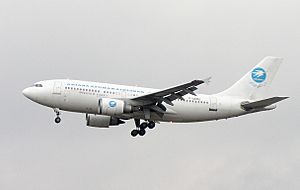
Air transport in Afghanistan is provided by the national carrier, Ariana Afghan Airlines, and by the private company Kam Air. Airlines from a number of countries also provide flights in and out of the country. These include Air India, Emirates, Gulf Air, Iran Aseman Airlines, Pakistan International Airlines, and Turkish Airlines. The country has four international airports: Hamid Karzai International Airport (formerly Kabul International Airport), Kandahar International Airport, Herat International Airport, and Mazar-e Sharif International Airport. Including domestic airports, there are 43. Bagram Air Base is a major military airfield.
The country has three rail links: one, a 75-kilometre (47 mi) line from Mazar-i-Sharif to the Uzbekistan border; a 10-kilometre (6.2 mi) long line from Toraghundi to the Turkmenistan border (where it continues as part of Turkmen Railways); and a short link from Aqina across the Turkmen border to Kerki, which is planned to be extended further across Afghanistan. These lines are used for freight only and there is no passenger service. A rail line between Khaf, Iran and Herat, western Afghanistan, intended for both freight and passengers, is under construction as of 2019. About 125 kilometres (78 mi) of the line will lie on the Afghan side. There are various proposals for the construction of additional rail lines in the country.
Private vehicle ownership has increased substantially since the early 2000s. Taxis are yellow in color and consist of both cars and auto rickshaws. In rural Afghanistan, villagers often use donkeys, mules or horses to transport or carry goods. Camels are primarily used by the Kochi nomads. Bicycles are popular throughout Afghanistan.
Culture
Afghans have both common cultural features and those that differ between the regions of Afghanistan, each with distinctive cultures partly as a result of geographic obstacles that divide the country. Family is the mainstay of Afghan society and families are often headed by a patriarch. In the southern and eastern region, the people live according to the Pashtun culture by following Pashtunwali (the Pashtun way). Key tenets of Pashtunwali include hospitality, the provision of sanctuary to those seeking refuge, and revenge for the shedding of blood. The Pashtuns are largely connected to the culture of Central Asia and the Iranian Plateau. The remaining Afghans are culturally Persian and Turkic. Some non-Pashtuns who live in proximity with Pashtuns have adopted Pashtunwali in a process called Pashtunization, while some Pashtuns have been Persianized. Those who have lived in Pakistan and Iran over the last 30 years have been further influenced by the cultures of those neighboring nations. The Afghan people are known to be strongly religious.
Afghans, particularly Pashtuns, are noted for their tribal solidarity and high regard for personal honor. One writer considers the tribal system to be the best way of organizing large groups of people in a country that is geographically difficult, and in a society that, from a materialistic point of view, has an uncomplicated lifestyle. There are various Afghan tribes, and an estimated 2–3 million nomads. Afghan culture is deeply Islamic, but pre-Islamic practices persist. Child marriage is prevalent in Afghanistan; the legal age for marriage is 16. The most preferred marriage in Afghan society is to one's parallel cousin, and the groom is often expected to pay a bride price.

In the villages, families typically occupy mudbrick houses, or compounds with mudbrick or stone walled houses. Villages typically have a headman (malik), a master for water distribution (mirab) and a religious teacher (mullah). Men would typically work on the fields, joined by women during harvest. About 15% of the population are nomadic, locally called kochis. When nomads pass villages they often buy supplies such as tea, wheat and kerosene from the villagers; villagers buy wool and milk from the nomads.
Afghan clothing for both men and women typically consists of various forms of shalwar kameez, especially perahan tunban and khet partug. Women would normally wear a chador for head covering; some women, typically from highly conservative communities, wear the burqa, a full body covering. These were worn by some women of the Pashtun community well before Islam came to the region, but the Taliban enforced this dress on women when they were in power. Another popular dress is the chapan which acts as a coat. The karakul is a hat made from the fur of a specific regional breed of sheep. It was favored by former kings of Afghanistan and became known to much of the world in the 21st century when it was constantly worn by President Hamid Karzai. The pakol is another traditional hat originating from the far east of the country; it was popularly worn by the guerrilla leader Ahmad Shah Massoud. The Mazari hat originates from northern Afghanistan.
Architecture
The nation has a complex history that has survived either in its current cultures or in the form of various languages and monuments. Afghanistan contains many remnants from all ages, including Greek and Buddhist stupas, monasteries, monuments, temples and Islamic minarets. Among the most well known are the Great Mosque of Herat, the Blue Mosque, the Minaret of Jam, the Chil Zena, the Qala-i Bost in Lashkargah, the ancient Greek city of Ai-Khanoum. However, many of its historic monuments have been damaged in modern times due to the civil wars. The two famous Buddhas of Bamiyan were destroyed by the Taliban, who regarded them as idolatrous. Despite that, archaeologists are still finding Buddhist relics in different parts of the country, some of them dating back to the 2nd century. As there was no colonialism in the modern era in Afghanistan, European-style architecture is rare but does exist: the Victory Arch at Paghman and the Darul Aman Palace in Kabul were built in this style in the 1920s by the Afghans themselves.
Afghan Architecture also ranges deep into India such as the Tomb of Sher Shah Suri, an Afghan Emperor of India.
Art and ceramics
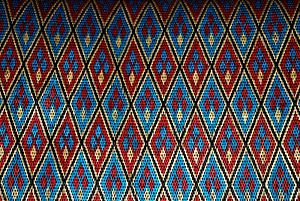
Carpet weaving is an ancient practice in Afghanistan, and many of these are still handmade by tribal and nomadic people today. Carpets have been produced in the region for thousands of years and traditionally done by women. Some crafters express their feelings through the designs of rugs; for example after the outbreak of the Soviet–Afghan War, "war rugs", a variant of Afghan rugs, were created with designs representing pain and misery caused by the conflict. Every province has its own specific characteristics in making rugs. In some of the Turkic-populated areas in the north-west, bride and wedding ceremony prices are driven by the bride's weaving skills.
Pottery has been crafted in Afghanistan for millennia. The village of Istalif, north of Kabul, is in particular a major center, known for its unique turquoise and green pottery, and their methods of crafting have remained the same for centuries. Much of lapis lazuli stones were earthed in modern-day Afghanistan which were used in Chinese porcelain as cobalt blue, later used in ancient Mesopotamia and Turkey.
The lands of Afghanistan have a long history of art, with the world's earliest known usage of oil painting found in cave murals in the country. A notable art style that developed in Afghanistan and eastern Pakistan is Gandhara Art, produced by a fusion of Greco-Roman art and Buddhist art between the 1st and 7th centuries CE. Later eras saw increased use of the Persian miniature style, with Kamaleddin Behzad of Herat being one of the most notable miniature artists of the Timurid and early Safavid periods. Since the 1900s, the nation began to use Western techniques in art. Abdul Ghafoor Breshna was a prominent Afghan painter and sketch artist from Kabul during the 20th century.
Media and entertainment
Afghanistan has around 350 radio stations and over 200 television stations. Radio Television Afghanistan, originating from 1925, is the state public broadcaster. Television programs began airing in the 1970s and today there are many private television channels such as TOLO and Shamshad TV. The first Afghan newspaper was published in 1873, and there are hundreds of print outlets today. By the 1920s, Radio Kabul was broadcasting local radio services. Voice of America, BBC, and Radio Free Europe/Radio Liberty (RFE/RL) broadcast in both of Afghanistan's official languages on radio. Press restrictions have been gradually relaxed and private media diversified since 2002, after more than two decades of tight controls.
Afghans have long been accustomed to watching Indian Bollywood films and listening to its filmi songs. It has been claimed that Afghanistan is among the biggest markets for the Hindi film industry. The stereotypes of Afghans in India (Kabuliwala or Pathani) have also been represented in some Bollywood films by actors. Many Bollywood film stars have roots in Afghanistan, including Salman Khan, Saif Ali Khan, Aamir Khan, Feroz Khan, Kader Khan, Naseeruddin Shah, Zarine Khan, Celina Jaitly, and a number of others. Several Bollywood films have been shot inside Afghanistan, including Dharmatma, Khuda Gawah, Escape from Taliban, and Kabul Express.
Music
Afghan classical music has close historical links with Indian classical music and use the same Hindustani terminology and theories like raga. Genres of this style of music include ghazal (poetic music) and instruments such as the Indian tabla, sitar and harmonium, and local instruments like zerbaghali, as well as dayereh and tanbur which are also known in Central Asia, the Caucasus and the Middle East. The rubab is the country's national instrument and precurses the Indian sarod instrument. Some of the famous artists of classical music include Ustad Sarahang and Sarban.
Pop music developed in the 1950s through Radio Kabul and was influential in social change. During this time female artists also started appearing, at first Mermon Parwin. Perhaps the most famous artist of this genre was Ahmad Zahir, who synthesized many genres and continues to be renowned for his voice and rich lyrics long after his death in 1979. Other notable masters of traditional or popular Afghan music include Nashenas, Ubaidullah Jan, Mahwash, Ahmad Wali, Farhad Darya, and Naghma.
Attan is the national dance of Afghanistan, a group dance popularly performed by Afghans of all backgrounds. The dance is considered part of Afghan identity.
Cuisine
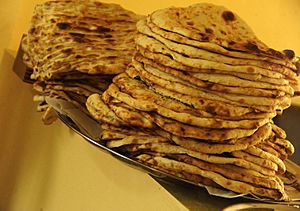
Afghan cuisine is largely based upon the nation's chief crops, such as wheat, maize, barley and rice. Accompanying these staples are native fruits and vegetables as well as dairy products such as milk, yogurt, and whey. Kabuli palaw is the national dish of Afghanistan. The nation's culinary specialties reflect its ethnic and geographic diversity. Afghanistan is known for its high-quality pomegranates, grapes, and sweet melons. Tea is a favorite drink among Afghans. A typical Afghan diet consists of naan, yogurt, rice, and meat.
Literature
Classic Persian and Pashto poetry are a cherished part of Afghan culture. Poetry has always been one of the major educational pillars in the region, to the level that it has integrated itself into culture. One of the poetic styles is called landay. A popular theme in Afghan folklore and mythology are Divs, monstrous creatures. Thursdays are traditionally "poetry night" in the city of Herat when men, women and children gather and recite both ancient and modern poems.
The Afghan region has produced countless Persian-speaking poets and writers from the Middle Ages to the present day, among which three mystical authors are considered true national glories (although claimed with equal ardor by Iran), namely: Khwaja Abdullah Ansari of Herat, a great mystic and Sufi saint in the 11th century, Sanai of Ghazni, author of mystical poems in the 12th century, and, finally, Rumi of Balkh, in the 13th century, considered the persophonist throughout the world as the greatest mystical poet of the entire Muslim world. The Afghan Pashto literature, although quantitatively remarkable and in great growth in the last century, has always had an essentially local meaning and importance, feeling the influence of both Persian literature and the contiguous literatures of India. Both main literatures, from the second half of the nineteenth century, have shown themselves to be sensitive to genres (novel, theater), movements and stylistic features imported from Europe.
Khushal Khan Khattak of the 17th century is considered the national poet. Other notable poets include Rabi'a Balkhi, Jami, Rahman Baba, Khalilullah Khalili, and Parween Pazhwak.
Holidays and festivals
Afghanistan's official New Year starts with Nowruz, an ancient tradition that started as a Zoroastrian celebration in present-day Iran, and with which it shares the annual celebration along with several other countries. It occurs every year at the vernal equinox. In Afghanistan, Nowruz is typically celebrated with music and dance, as well as holding buzkashi tournaments.
Yaldā, another nationally celebrated ancient tradition, commemorates the ancient goddess Mithra and marks the longest night of the year on the eve of the winter solstice (čelle ye zemestān; usually falling on 20 or 21 December), during which families gather together to recite poetry and eat fruits—particularly the red fruits watermelon and pomegranate, as well as mixed nuts.
Religious festivals are also celebrated; as a predominantly Muslim country, Islamic events and festivals such as Ramadan, Eid al-Fitr and Ashura are widely celebrated annually in Afghanistan. The Sikh festival of Vaisakhi is celebrated by the Sikh community and the Hindu festival Diwali by the Hindu community.
National Independence Day is celebrated on 19 August to mark the Anglo-Afghan Treaty of 1919 under King Amanullah Khan and the country's full independence. Several international celebrations are also officially held in Afghanistan, such as International Workers' Day and International Women's Day. Some regional festivals include the Pamir Festival, which celebrates the culture of the Wakhi and Kyrgyz peoples, the Red Flower Festival (during Nowruz) in Mazar-i-Sharif and the Damboora Festival in Bamyan Province.
Sports
Sport in Afghanistan is managed by the Afghan Sports Federation. Cricket and Association football are the two most popular sports in the country. The Afghan Sports Federation promotes cricket, association football, basketball, volleyball, golf, handball, boxing, taekwondo, weightlifting, bodybuilding, track and field, skating, bowling, snooker, chess, and other sports.
Afghanistan's sports teams are increasingly celebrating titles at international events. basketball team won the first team sports title at the 2010 South Asian Games. Later that year, the country's cricket team followed it with the winning of 2009–10 ICC Intercontinental Cup. In 2012, the country's 3x3 basketball team won the gold medal at the 2012 Asian Beach Games. In 2013, Afghanistan's football team followed as it won the SAFF Championship.
The Afghan national cricket team, which was formed in 2001, participated in the 2009 ICC World Cup Qualifier, 2010 ICC World Cricket League Division One and the 2010 ICC World Twenty20. It won the ACC Twenty20 Cup in 2007, 2009, 2011 and 2013. The team eventually made it and played in the 2015 Cricket World Cup. The Afghanistan Cricket Board (ACB) is the official governing body of the sport and is headquartered in Kabul. The Alokozay Kabul International Cricket Ground serves as the nation's main cricket stadium. There are several other stadiums throughout the country, including the Ghazi Amanullah Khan International Cricket Stadium near Jalalabad. Domestically, cricket is played between teams from different provinces.
The Afghanistan national football team has been competing in international football since 1941. The national team plays its home games at the Ghazi Stadium in Kabul, while football in Afghanistan is governed by the Afghanistan Football Federation. The national team has never competed or qualified for the FIFA World Cup but has recently won an international football trophy in 2013. The country also has a national team in the sport of futsal, a 5-a-side variation of football.
The traditional and the national sport of Afghanistan is buzkashi, mainly popular in the north, but also having a following in other parts of the country. It is similar to polo, played by horsemen in two teams, each trying to grab and hold a goat carcass. The Afghan Hound (a type of running dog) originated in Afghanistan and was formerly used in wolf hunting. In 2002, traveler Rory Stewart reported that dogs were still used for wolf hunting in remote areas.
Interesting facts about Afghanistan
- Afghanistan is officially called the Islamic Emirate of Afghanistan.
- Afghanistan is located in Central and South Asia.
- Afghanistan used to be part of the Persian Empire.
- Afghanistan used to be on the trade route to China and India. It is near what used to be the Silk Road.
- It made money from the lapis lazuli, a beautiful blue mineral that is also a gemstone.
- In the 7th Century, Arabs came and made Islam the religion of Afghanistan and Islamic dynasties ruled for centuries.
- Afghanistan has many mountains, and it contains part of the Himalayas.
- Afghanistan has a continental climate. It has hot summers and cold winters.
- Southern Afghanistan is dry, so there are fewer plants.
- Afghanistan used to have tigers, but because of years of war, hunting, and years of no water, the tigers are gone.
- The people who live in Afghanistan are called Afghans.
- Dari-Persian and Pashto are the official languages of Afghanistan.
- There are few major cities in Afghanistan, but about one-fifth of the total population live in cities.
Images for kids
-
Tents of Afghan nomads in the northern Badghis province of Afghanistan. Early peasant farming villages came into existence in Afghanistan about 7,000 years ago.
-
The extent of the Indus Valley civilization during its mature phase
-
Approximate maximum extent of the Greco-Bactrian kingdom, formed by the fragmentation of Alexander the Great's Empire, circa 180 BCE
-
Saffarid rule at its greatest extent under Ya'qub ibn al-Layth al-Saffar
-
Map of the Hotak Empire during the Reign of Mirwais Hotak, 1715.
-
Portrait of Ahmad Shah Durrani c. 1757.
-
Emir Amanullah invaded British India in 1919 and proclaimed Afghanistan's full independence thereafter. He proclaimed himself King of Afghanistan in June 1926.
-
King Zahir, the last reigning monarch of Afghanistan, who reigned from 1933 until 1973.
-
Taliban fighters in Kabul on a captured Humvee following the 2021 fall of Kabul.
-
The mountainous topography of Afghanistan
See also
 In Spanish: Afganistán para niños
In Spanish: Afganistán para niños
- Outline of Afghanistan
- History of Afghanistan




